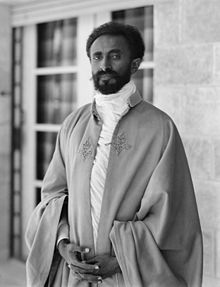Haile Selassie I
From Wikipedia, the free encyclopedia
| Haile Selassie I | |
|---|---|
 |
|
| Reign | 2 November 1930 – 12 September 1974 |
| Coronation | 2 November 1930 |
| Predecessor | Zewditu I |
| Successor | De jure Amha Selassie I (crowned in exile) |
| Predecessor | Zewditu I |
| Successor | Aman Andom (as Chairman of the Derg) |
| Spouse | Empress Menen |
| Issue | |
| Princess Romanework Princess Tenagnework Asfaw Wossen Princess Zenebework Princess Tsehai Prince Makonnen Prince Sahle Selassie |
|
| Full name | |
| Ras Tafari Makonnen | |
| House | House of Solomon |
| Father | Ras Makonnen Woldemikael Gudessa |
| Mother | Weyziro Yeshimebet Ali Abajifar |
| Born | 23 July 1892 Ejersa Goro, Ethiopia |
| Died | 27 August 1975 (aged 83) Addis Ababa, Ethiopia |
| Burial | Holy Trinity Cathedral |
| Religion | Ethiopian Orthodox Tewahedo |
| Styles of Haile Selassie I of Ethiopia |
|
|---|---|
| Reference style | His Imperial Majesty |
| Spoken style | Your Imperial Majesty |
| Alternative style | Sire |
At the League of Nations in 1936, the Emperor condemned the use of chemical weapons by Italy against his people during the Second Italo–Ethiopian War.[5] His internationalist views led to Ethiopia becoming a charter member of the United Nations, and his political thought and experience in promoting multilateralism and collective security have proved seminal and enduring.[6] His suppression of rebellions among the nobles (mekwannint), as well as what some[who?] perceived to be Ethiopia's failure to modernize adequately,[7] earned him criticism among some contemporaries and historians.[8]
Among the Rastafari movement, whose followers are estimated at between 200,000 and 800,000, Haile Selassie is revered as the returned messiah of the Bible, God incarnate.[9][10] Beginning in Jamaica in the 1930s, the Rastafari movement perceives Haile Selassie as a messianic figure who will lead a future golden age of eternal peace, righteousness, and prosperity.[11] Haile Selassie was an Ethiopian Orthodox Christian throughout his life.

No comments:
Post a Comment